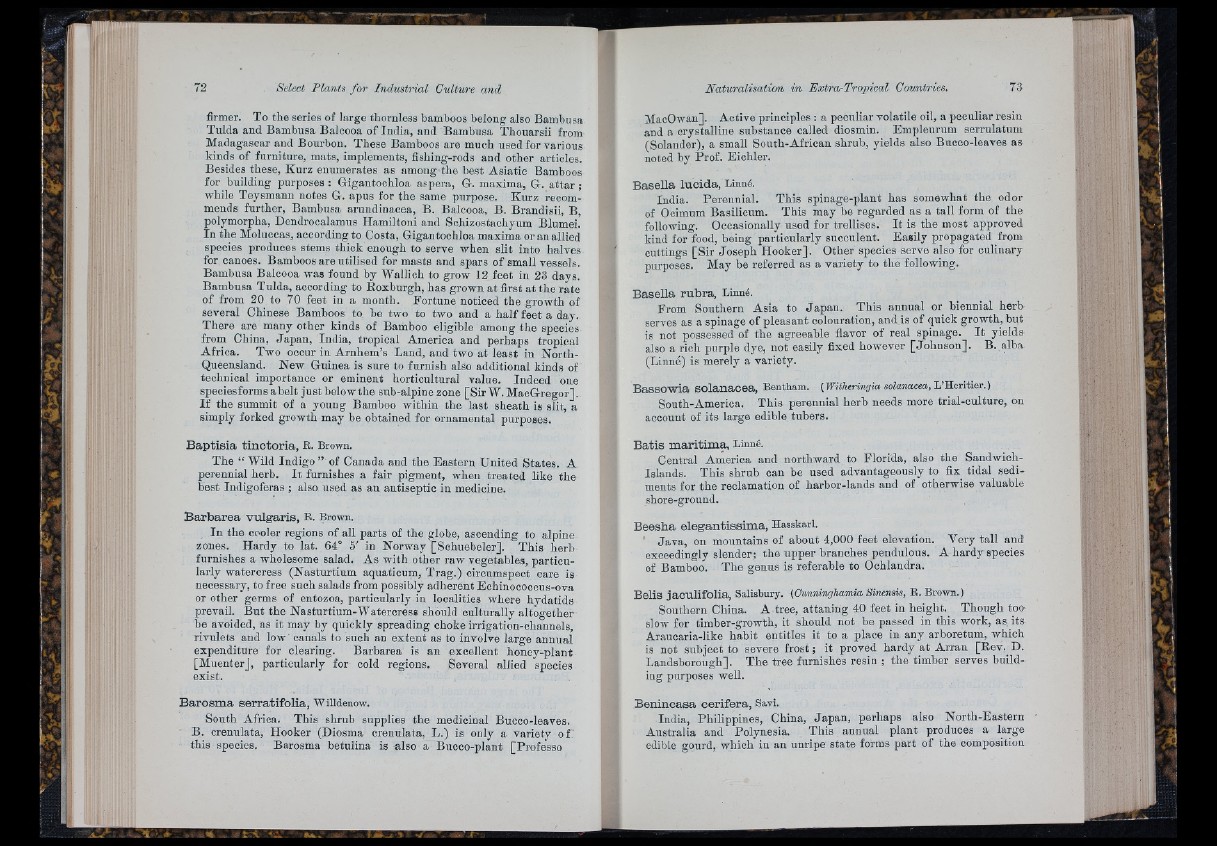
Select Plants fo r Industrial Culture and
firmer. To the series of large thornless bamboos belong also Bambusa
Tulda and Bambusa Balcooa of India, and Bambusa Thouarsii from
Madagascar and Bourbon. These Bamboos are much used for various
kinds of furniture, mats, implements, fishing-rods and other articles.
Besides these, Kurz enumerates as among the best Asiatic Bamboos
for building purposes : Gigantoohloa aspera, G. maxima, G. a tta r ;
while Teysmann notes G. apus for the same purpose. Kurz recommends
further, Bambusa arundinacea, B. Balcooa, B. Brandisii, B,
polymorpha, Dendrooalamus Hamiltoni and Schizostachyum Blumei.
In the Moluccas, according to Costa, Gigantochloa maxima or an allied
species produces stems thick enough to serve when slit into halves
for canoes. Bamboos are utilised for masts and spars o f small vessels.
Bambusa Balcooa was found by Wallich to grow 12 feet in 23 days.
Bambusa Tulda, according to Roxburgh, has grown a t first a t the rate
of from 20 to 70 feet in a month. Fortune noticed the growth of
several Chinese Bamboos to be two to two and a h a lf feet a day.
There are many other kinds of Bamboo eligible among the species
from China, Japan, India, tropical America and perhaps tropical
Africa. Two occur in Arnhem’s Land, aud two at least in Nortli-
Queensland. New Guinea is sure to furnish also additional kinds of
technical importance or eminent horticultural value. Indeed one
speciesforms abelt just belowthe snb-alpine zone [Sir W. M acGregor],
I f the summit of a young Bamboo within the last sheath is slit, a
simply forked growth may be obtained for ornamental purposes.
B a p tis ia tin c to r ia , R. Brown.
The “ Wild Indigo ” of Canada and the Eastern United States. A
perennial herb. Ir. furnishes a fair pigment, when treated like the
best Indigoferas ; also used as an antiseptic in medicine.
B a rb a re a v u lg a r is , R. Brown.
In the cooler regions of all parts of the globe, ascending to alpine
zones. Hardy to lat. 64° 6' in Norway [Schuebeler]. This herb
furnishes a wholesome salad. As with other raw vegetables, particularly
watercress (Nasturtium aquaticum, Trag.) circumspect care is
necessary, to free such salads from possibly adherent Echinococcus-ova
or other germs of entozoa, particularly in localities where hydatids
prevail. But the Nasturtium-Watercress should culturally altogether
be avoided, as it may by quickly spreading choke irrigatiou-channels,
rivulets and low' canals to such an extent as to involve large annual
expenditure for clearing. Barbarea is an excellent honey-plant
[Muenter], particularly for cold regions. Several allied species
exist.
B a ro sm a s e r ra tifo lia , W illdenow.
South Africa. This shrub supplies the medicinal Bucco-leaves.
B. crennlata. Hooker (Diosma crenulata, L.) is only a variety o f
this species. Barosma betulina is also a Bucoo-plant [Professo
MacOwan]. Active principles : a peculiar volatile oil, a peculiar resin
and a crystalline substance called diosmin. Empleurum serrulatum
(Solander), a small South-African shrub, yields also Bucco-leaves as
noted by Prof. Eichler.
BaseUa lu c id a , Linné.
India. Perennial. This spinage-plant has somewhat the odor
of Ocimum Basilicum. This may be regarded as a tall form of the
following. Occasionally used for trellises. I t is the most approved
kind for food, being particularly succulent. Easily propagated from
cuttings [S ir Joseph Hooker]. Other species serve also for culinary
purposes. May be referred as a variety to the following.
B asella ru b r a , Linné.
From Southern Asia to Jap an . This annual or biennial herb
serves as a spinage of pleasant colouration, and is of quick growth, but
is not possessed of the agreeable flavor of real spinage. I t yields
also a rich purple dye, not easily fixed however [Johnson]. B. alba
(Linné) is merely a variety.
BassO'wia so la n a c e a , Bentham. sotaacect, L’Heritier.)
South-America. This perennial herb needs more trial-eulture, on
account of its large edible tubers.
B a tis m a r itim a , Linné.
Central America and northward to Florida, also the Sandwich-
Islands. This shrub can be used advantageously to fix tidal sediments
for the reclamation of harbor-lands and of otherwise valuable
shore-ground.
B e e sh a e le g a n tis s im a , Hasskarl.
Java, on mountains of about 4,000 feet elevation. Very ta ll and
exceedingly slender; the upper branches pendulous. A hardy species
of Bamboo. The genus is referable to Ochlaudra.
Belis ja c u lifo lia , Salisbury. (Gunninghamia Sinensis, R. Brown.)
Southern China. A tree, attauing 40 feet in height.^ Though too.
slow for timber-growth, it should not be passed in this work, as its
Araucaria-like habit entitles it to a place in any arboretum, which
is not subject to severe frost ; it proved hardy a t Arran [Rev. D.
Landsborough]. The tree furnishes resin ; the timber serves building
purposes well.
B e n in c a s a c e rife ra , Savi.
India, Philippines, China, Jap an , perhaps also North-Eastern
Australia and Polynesia. This annual plant produces a large
edible gourd, which in an unripe state forms part of the composition
i
f è é f é :
•t ■ ■
I ' V : '